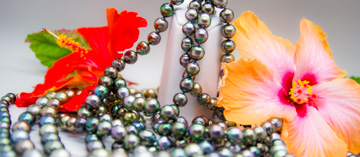If you are planning purchase Tahitian pearls, we have some tips to help you decide exactly which pearl is right for you. Tahitian cultured pearls are categorized according to five official criteria :
1 - The Lustre

The amount of lustre (shine, sheen) depends on how light is reflected from the pearl''s surface. A superb lustre means that a lot of light is reflected, creating a mirror-like effect.
A faint lustre means that the surface is dull and has poor light-reflecting qualities.
2 - Surface perfection

A naked-eye examination of a pearl’s surface is enough to assess its smoothness. Any alteration in the nacre is considered as a surface imperfection, such as: punctures, scratches, deposits, streaks and swellings.
A flawless perfectly smooth surface is rare and exceptional.
According to their luster and smoothness, pearls are classified into 5 categories: Top gem, A-grade, B-grade, C-grade, D-grade.
Rejects are pearls whose surface quality is lower than D-grade. Marketing and exporting such pearls is prohibited.
3 - Size

Size refers to the pearl's diameter, measured in millimetres and usually ranges from 8mm to 16mm.
4 - Shape

There are seven basic shapes: Round (refers to a perfect sphere), Semi-round, Drop, Oval, Button, Semi-baroque and Baroque (featuring an uneven shape). Another category derives from the latter: ringed pearls called circled pearls.
5 - Color
Color is an additional criterion, which depends on your personal tastes. Tahiti cultured pearls naturally come in a wide array of disctinctive colors. You may choose from the following hues and tints : cherry, peacock, pistachio, golden, gray or white...
























